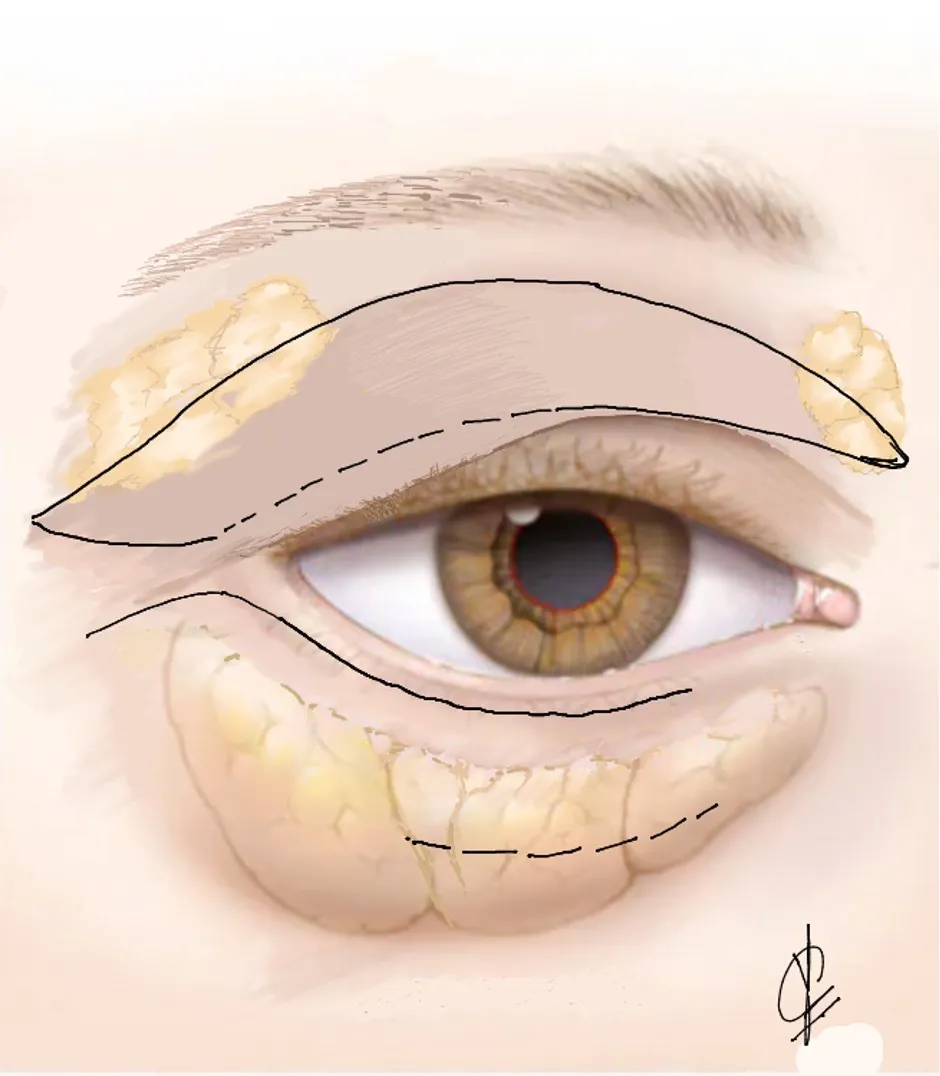Lower eyelid surgery (lower blepharoplasty) is often performed as part of periorbital (or peri orbital) rejuvenation and aims to reduce under-eye bags, perceived puffiness, and skin laxity (looseness). Lower eyelid surgery combined with periorbital rejuvenation offers a comprehensive approach to refreshing the eye area, with results that can be both natural and long-lasting. The goal is to achieve a refreshed appearance around the eyes while preserving natural contours.

What the Procedure Involves
Lower blepharoplasty may be performed under general anaesthesia or local anaesthesia with sedation. Techniques vary and may include:
- Incisions made just below the lower lash line or inside the lower eyelid (transconjunctival)
- Removal or repositioning of fat
- Tightening of skin or muscle and eyelid if required.
Your surgeon at Advanced Plastic & Cosmetic Surgery (APCS), will assess your eyes and skin quality to determine the best surgical approach.
What to Expect During the Procedure
Lower Eyelid Surgery process usually involves:
- Anaesthesia: Typically performed under local anaesthesia with minimal sedation, or sometimes under general anaesthesia, depending on the complexity and patient preference.
- Incisions: The surgeon makes incisions either just below the lashes or inside the lower eyelid (transconjunctival approach), depending on the need to remove excess skin or fat.
- Tissue Adjustment: Excess fat is removed or repositioned, and if needed, excess skin is trimmed and the area is sutured closed
- Any laxity of the lower eyelid is corrected at the same time.
- The procedure typically takes 1 to 2.5 hours, depending on the complexity and technique used.
Potential Benefits of Lower Eyelid Surgery & Periorbital Rejuvenation
This procedure may assist in:
- Smoothing puffiness or under-eye bags
- Reducing excess lower eyelid skin
- Enhancing the overall periorbital area appearance
Outcomes vary with individual anatomy and healing.
Risks and Considerations
Modern surgery is generally safe, but as with any surgical procedure, lower blepharoplasty surgery and periorbital rejuvenation procedures carry risks. These include dry or irritated eyes, changes in eyelid contour, and asymmetry. Rare complications may include infection or scarring. Working with a certified and experienced plastic surgeon significantly minimises these risks. For a list of general and specific risks and complications associated with plastic surgery and eyelid surgery, please click here to download.
During your consultation, your APCS surgeon will talk about possible risks and complications. It is essential to grasp these factors before deciding to proceed with a lower eyelid procedure. Any concerns should be communicated to the team at Advanced Plastic & Cosmetic Surgery.
Recovery and Aftercare
Recovery experiences may vary for lower eyelid surgery, but typical recovery milestones include:
- First Week: Swelling and bruising are common. Cold compresses are recommended.
- 2–4 Weeks: Most patients resume daily activities. Visible signs of surgery reduce.
- 3–6 Months: Healing continues and scars fade.
For non-surgical periorbital rejuvenation treatments (fillers, Botox, lasers), downtime is minimal, with possible minor swelling or bruising that typically resolves quickly.
Your surgeon will provide detailed instructions for care and activity. These instructions may include:
- How to care for your surgical site(s) following surgery
- Medications to apply or take orally to aid healing and reduce the risk of infection
- Specific concerns to look for at the surgical site(s) or in your general health
- When to schedule follow-up appointments with your plastic surgeon
Your APCS plastic surgeon may elect to follow up with patients for up to one year to monitor their progress and ensure they are satisfied with the final outcomes.
Who Might Be Suitable for Lower Eyelid Surgery & Periorbital Rejuvenation?
Those who may benefit from lower eyelid surgery and periorbital rejuvenation include individuals who:
- Have concerns about the natural ageing process beneath the eyes
- Are in good health
- Have realistic expectations
Consultation with a RACS Certified, and experienced plastic surgeon is required to assess individual suitability. The decision to undergo lower eyelid surgery and periorbital rejuvenation should be based on a thorough consultation with a registered specialist plastic surgeon who can assess your individual needs and explain potential outcomes and risks.
Frequently Asked Questions
Q: Is this the same as upper eyelid surgery?
A: No. Lower blepharoplasty targets concern beneath the eye, while upper blepharoplasty addresses the upper eyelids.
Q: Will it change my eye shape?
A: The goal is to maintain or enhance natural contours, not change eye shape.
Q: Can upper and lower eyelid surgery be performed together?
A: Yes, upper and lower eyelid surgery, also known as blepharoplasty, can be performed together. Most patients opt to do this for a more comprehensive approach.
Important Note
Surgical outcomes can vary significantly between individuals. Any before-and-after images or descriptions of outcomes (not included here) are not indicative of what every patient may achieve. Only a consultation with a RACS Certified plastic surgeon can determine whether the lower eyelid surgery procedure (lower blepharoplasty) is suitable for you.
